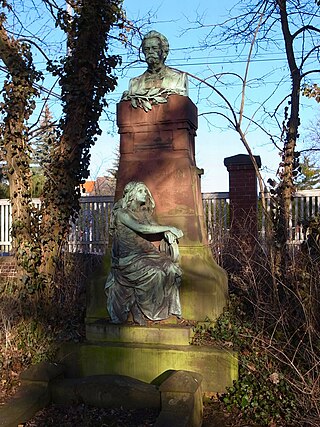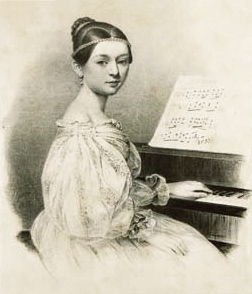A concerto is, from the late Baroque era, mostly understood as an instrumental composition, written for one or more soloists accompanied by an orchestra or other ensemble. The typical three-movement structure, a slow movement preceded and followed by fast movements, became a standard from the early 18th century.
Camille Saint-Saëns composed his Cello Concerto No. 1 in A minor, Op. 33, in 1872, when he was 37 years old. He wrote this work for the French cellist, viola da gamba player and instrument maker Auguste Tolbecque. Tolbecque was part of a distinguished family of musicians closely associated with the Société des Concerts du Conservatoire, France's leading concert society. The concerto was first performed on January 19, 1873, at the Paris Conservatoire concert with Tolbecque as soloist. This was considered a mark of Saint-Saëns' growing acceptance by the French musical establishment.

August Friedrich Martin Klughardt was a German composer and conductor.
Sergio Berlioz is a composer and musicologist who has participated in over 4000 conferences, round tables and concerts; with almost four decades of academic experience, Sergio Berlioz has taught and given seminars and lectures on music and history of art at various universities and cultural institutions throughout Mexico and the Czech Republic. He currently teaches in Casa Lamm, where his "Musical wednesday" conferences have become popular, and in the Instituto Cultural México Israel where he was recognized in 2015 as a valuable teacher and lecturer collaborating over twenty years in that institution.
The Symphony for Cello and Orchestra or Cello Symphony, Op. 68, was written in 1963 by the British composer Benjamin Britten. He dedicated the work to Mstislav Rostropovich, who gave the work its premiere in Moscow with the composer and the Moscow Philharmonic Orchestra on 12 March 1964. The work's title reflects the music's more even balance between soloist and orchestra than in the traditional concerto format.
Carl Maria von Weber's Concerto for Bassoon in F Major, Op. 75 was composed in 1811 for Munich court musician Georg Friedrich Brandt, was premiered on December 28, 1811, and then revised in 1822. Primarily an opera conductor and composer, Weber had only arrived a few months earlier in Munich, where he was extremely well received. The concerto is one of two pieces written for bassoon by Weber, the other being Andante e Rondo Ungarese, Op. 35. A typical performance lasts 18–20 minutes.

Graham Waterhouse is an English composer and cellist who specializes in chamber music. He has composed a cello concerto, Three Pieces for Solo Cello and Variations for Cello Solo for his own instrument, and string quartets and compositions that juxtapose a quartet with a solo instrument, including Piccolo Quintet, Bassoon Quintet and the piano quintet Rhapsodie Macabre. He has set poetry for speaking voice and cello, such as Der Handschuh, and has written song cycles. His compositions reflect the individual capacity and character of players and instruments, from the piccolo to the contrabassoon.

The Bassoon Quintet is a quintet by Graham Waterhouse, composed in 2003 for bassoon and string quartet.

Bei Nacht, op. 50, is a piano trio, composed in 1999 by Graham Waterhouse, published by Hofmeister, Leipzig.

Three Pieces for Solo Cello op. 28, is a composition for cello in three movements by Graham Waterhouse, dedicated to cellist Siegfried Palm in 1992. The composer, a cellist himself, wrote it to "exploit the characteristics" of his instrument. In 1996, a revised version won a composition prize and was performed at the Hochschule für Musik München. The work was published by the Friedrich Hofmeister Musikverlag in 1996 and recorded on a Portrait CD of chamber music in 2001.

Symphony No. 5, also called Sinfonía para cuerdas is a composition for string orchestra by Carlos Chávez, composed in 1953.

Rhapsodie Macabre is a composition for piano and string quartet in one movement by Graham Waterhouse, written in 2011 as a homage to Franz Liszt. It was first performed at a Liszt festival of the Gasteig, Munich, with the composer playing the cello part.

Zeichenstaub is a composition for string trio in four movements by Graham Waterhouse, written in 2010. It was first performed in Arnstadt, Germany, on 18 September 2010, with the composer playing the cello part.

Graham Waterhouse, cellist and composer especially of chamber music, has written a number of works for string quartet, three major works in several movements, several smaller works and compositions for a solo instrument and string quartet.
Chieftain's Salute is a concerto in one movement for Great Highland Bagpipe and orchestra by Graham Waterhouse. The work is one of few to use the bagpipe with a classical orchestra. A version for bagpipe and string orchestra, Op. 34a, was composed in 2001. It is based on an earlier work for bagpipe and string quartet. Jacobean Salute was also derived from the early work, with a wind quintet replacing the bagpipe, published in 2003. A version for bagpipe and orchestra was composed and first performed in 2015.

Carlos Chávez's Violin Concerto is a work for violin and orchestra composed between 1945 and 1950 for the American violinist Viviane Bertolami. Originally 45 minutes in length, it was shortened soon after its first performance to a duration of approximately 35 minutes.

Concerto for Piano with Orchestra is a piano concerto by the Mexican composer Carlos Chávez, written between 1938 and 1940.

The Piano Concerto in A minor, Op. 7, was composed by Clara Wieck, better known as Clara Schumann after her later marriage to Robert Schumann. She completed her only finished piano concerto in 1835, and played it first that year with the Leipzig Gewandhaus Orchestra, conducted by Felix Mendelssohn.
Four Epigraphs after Escher, Op. 35, is a chamber music composition by Graham Waterhouse, written in 1993 for viola, heckelphone and piano. Its four movements refer to graphic artworks by M. C. Escher. It was premiered in Munich in 1995, and the U.S. premiere was given in 1998. It was published by Hofmeister in 1998.





